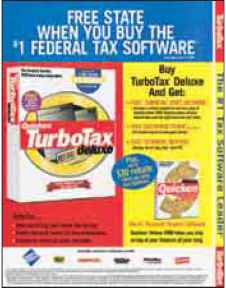Refunds and Rebates
Refunds (also known as rebates) are offers by the manufacturer to return a portion of the product purchase price, usually after the consumer supplies some proof of purchase. Consumers are generally very responsive to rebate offers, particularly as the size of the savings increases. Rebates are used by makers of all types of products, ranging from packaged goods to major appliances, cars, and computer software. Exhibit 16-21 shows an ad promoting a $30 rebate on Intuit's a rebate offer to promote popular tax and financial software products, TurboTax and Quicken. its Qukken software Packaged-goods marketers often use refund offers to induce trial of a new product products or encourage users of another brand to switch. Consumers may perceive the savings offered through a cash refund as an immediate value that lowers the cost of the item, even though those savings are realized only if the consumer redeems the refund or rebate offer. Redemption rates for refund offers typically range from 1 to 3 percent for print and point-of-purchase offers and 5 percent for in/on-package offers.
Refund offers can also encourage repeat purchase. Many offers require consumers to send in multiple proofs of purchase. The size of the refund offer may even increase as the number of purchases gets larger. Some packaged-goods companies are switching away from cash refund offers to coupons or cash/coupon combinations. Using coupons in the refund offer enhances the likelihood of repeat purchase of the brand.
Rebates have become a widely used form of promotion for consumer durables. Products such as cameras, sporting goods, appliances, televisions, audio and video equipment, computers, and cars frequently use rebate offers to appeal to price-conscious consumers. The use of rebates for expensive items like cars was begun by Chrysler Corp. in 1981 to boost sales and generate cash for the struggling company. Rebates are now common not only in the auto industry and other durable products but for packaged-goods products as well.
Evaluating Refunds and Rebates Rebates can help create new users and encourage brand switching or repeat purchase behavior, or they can be a way to offer a temporary price reduction. The rebate may be perceived as an immediate savings even though many consumers do not follow through on the offer. This perception can influence purchase even if the consumer fails to realize the savings, so the marketer can reduce price for much less than if it used a direct price-off deal.
Some problems are associated with refunds and rebates. Many consumers are not motivated by a refund offer because of the delay and the effort required to obtain the savings. They do not want to be bothered saving cash register receipts and proofs of purchase, filling out forms, and mailing in the offer.45 A study of consumer perceptions found a negative relationship between the use of rebates and the perceived difficulties associated with the redemption process.46 The study also found that consumers perceive manufacturers as offering rebates to sell products that are not faring well. Nonusers of rebates were particularly likely to perceive the redemption process as too complicated and to suspect manufacturers' motives. This implies that companies using rebates must simplify the redemption process and use other promotional elements such as advertising to retain consumer confidence in the brand.

- Exhibit 16-21 Intuit uses
When small refunds are being offered, marketers may find other promotional incentives such as coupons or bonus packs more effective. They must be careful not to overuse rebate offers and confuse consumers about the real price and value of a product or service. Also, consumers can become dependent on rebates and delay their purchases or purchase only brands for which a rebate is available. Many retailers have become disenchanted with rebates and the burden and expense of administering them.47
Continue reading here: Bonus Packs
Was this article helpful?
Readers' Questions
-
Florian2 months ago
- Reply
-
reino7 months ago
- Reply
-
bellisima1 year ago
- Reply